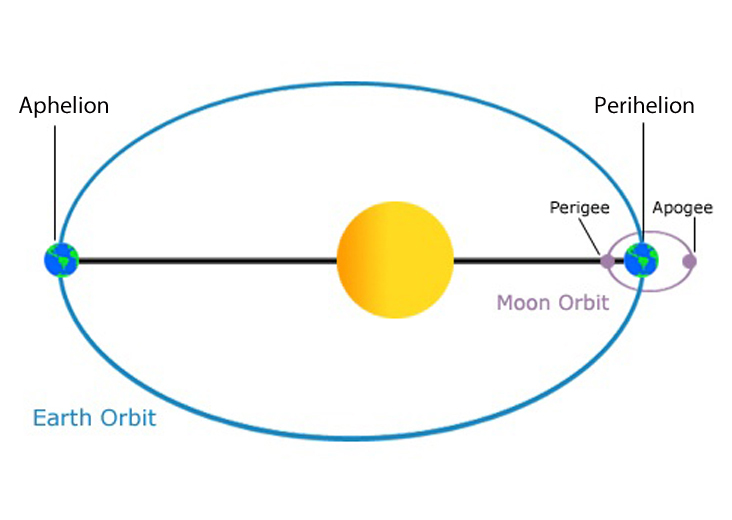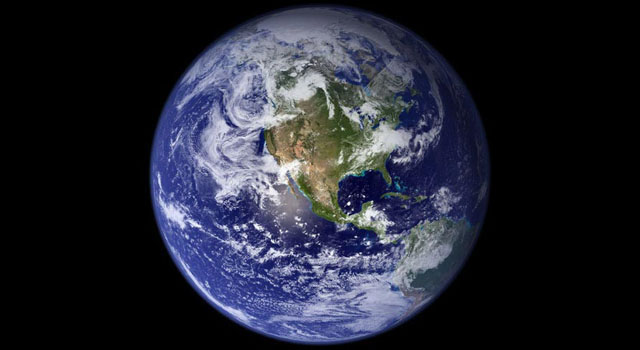Earth and Sun Snuggle Up for Closest Encounter of the Year

Early this morning (Jan. 3), Earth and the sun had their closest encounter of the year.
Earth's orbit around the sun is not perfectly circular, and today the planet reached perihelion, or its nearest point to the star in its yearly orbit. The close approach took place at 12:35 a.m. EDT (0535 GMT).
At perihelion, Earth is about 91.6 million miles (147.5 million kilometers) from the sun, compared to about 94.5 million miles (152.1 million km) when it's at aphelion, its farthest distance from the star, according to NASA. The difference between perihelion and aphelion for the Earth is about 3 million miles (4.8 million km), which isn't a tremendous distance, cosmically speaking, and has very little effect on the planet's inhabitants. [NASA's Best Photos of Earth from Space of 2017 (Gallery)]
"The sun is the big controller of the radiation that the Earth receives," Walter Petersen, a research physical scientist in the Earth science branch at NASA's Marshal Spaceflight Center, told Space.com. "But even when you take into account that difference in distance between aphelion and perihelion, there's only about a 7 percent difference in average global [solar energy] that we receive. And so it doesn't amount to a great deal in terms of weather."
While perihelion may not affect the weather, it does create a slight difference in the length of winter in the two hemispheres. Because perihelion happens in January, winter is about five days shorter in the Northern Hemisphere, compared with the Southern Hemisphere.
Here's why: Earth's seasons are caused by the planet's tilted axis. As Earth orbits the sun, the tilt causes one hemisphere to point slightly away from the star (and receive less sunlight) while the other hemisphere points slightly toward it (and receives more sunlight). This orientation switches about every six months; the hemisphere pointed toward the sun experiences summer, while the hemisphere that is pointed away experiences winter.
Winter begins in the Northern Hemisphere on the winter solstice, or the day when the sun is at its lowest point in the sky (making it the shortest day of the year). Winter lasts until the spring equinox, or the midway point between the winter and summer solstices. The solstices occur at opposite points in Earth's orbit around the sun, as do the equinoxes. If Earth moved at a steady speed in its orbit, then the same amount of time would pass between the solstices and the equinoxes. But that's not the case.
Breaking space news, the latest updates on rocket launches, skywatching events and more!
Kepler's laws of motion show that an orbiting body will sweep out equal areas in equal time. That means the object moves a little faster when it is close to its parent body, and moves a little slower when it is farther away from the parent. In other words, Earth will move slightly faster around perihelion (in January) than when it is at aphelion (in July). As a result, the time between the Northern Hemisphere's winter solstice (in December) and the spring equinox (in March) is a little less than the time between the Southern Hemisphere's winter solstice (in June) and the spring equinox (in September). The difference adds up to about five days.
Earth's distance from the sun changes slightly because its orbit is not perfectly circular but is instead slightly elongated, a feature known as an orbit's "eccentricity." But Earth's orbit is only slightly eccentric, so winter in the Northern Hemisphere is only five days shorter than it is in the Southern Hemisphere. But some of the other planets orbiting the sun have much higher eccentricities than Earth, and that can mean a bigger difference in how significantly the planet's arrival at perihelion and aphelion can affect global temperatures, according to NASA. On Mars, for example, the southern hemisphere winter is 24 days longer than it is in the northern hemisphere. Imagine how different life on Earth would be if that were the case here!
Follow Calla Cofield @callacofield. Follow us @Spacedotcom, Facebook and Google+. Original article on Space.com.

Calla Cofield joined Space.com's crew in October 2014. She enjoys writing about black holes, exploding stars, ripples in space-time, science in comic books, and all the mysteries of the cosmos. Prior to joining Space.com Calla worked as a freelance writer, with her work appearing in APS News, Symmetry magazine, Scientific American, Nature News, Physics World, and others. From 2010 to 2014 she was a producer for The Physics Central Podcast. Previously, Calla worked at the American Museum of Natural History in New York City (hands down the best office building ever) and SLAC National Accelerator Laboratory in California. Calla studied physics at the University of Massachusetts, Amherst and is originally from Sandy, Utah. In 2018, Calla left Space.com to join NASA's Jet Propulsion Laboratory media team where she oversees astronomy, physics, exoplanets and the Cold Atom Lab mission. She has been underground at three of the largest particle accelerators in the world and would really like to know what the heck dark matter is. Contact Calla via: E-Mail – Twitter


